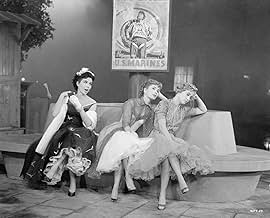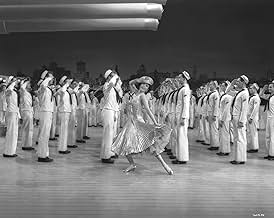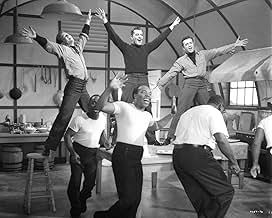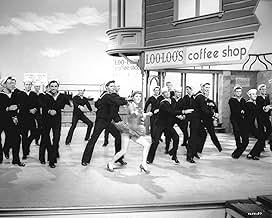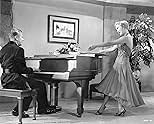NOTE IMDb
6,5/10
1 k
MA NOTE
Ajouter une intrigue dans votre langueThree sailors come ashore in San Francisco and take the city by storm, but can they win the hearts of three women by song?Three sailors come ashore in San Francisco and take the city by storm, but can they win the hearts of three women by song?Three sailors come ashore in San Francisco and take the city by storm, but can they win the hearts of three women by song?
- Réalisation
- Scénario
- Casting principal
- Récompenses
- 1 victoire au total
The Jubalaires
- Themselves
- (as Jubalaires)
Jerry Antes
- Dancer
- (non crédité)
Jimmy Brooks
- Dancer
- (non crédité)
Buddy Bryan
- Dancer
- (non crédité)
Avis à la une
Though this film has plenty of talent in the lead roles, it has an unimpressive story and the songs are not inspiring as a whole. However, the film grew on me as it progressed. By its end, I found myself actually enjoying it.
The female leads are very strong. Consider Jane Powell, Debbie Reynolds and Ann Miller. But the three leading men do not generate as much on-screen magic, leaving the production imbalanced and the love stories uninspiring.
"On the Town" (1949)---in contrast---is a much stronger film, that possesses energy throughout.
The female leads are very strong. Consider Jane Powell, Debbie Reynolds and Ann Miller. But the three leading men do not generate as much on-screen magic, leaving the production imbalanced and the love stories uninspiring.
"On the Town" (1949)---in contrast---is a much stronger film, that possesses energy throughout.
'Hit the Deck' is not one of the classic film musicals (made during somewhat of a twilight period for MGM musicals), but there are far worse film musicals around before and since. To me, 'Hit the Deck' is problematic but underrated, and it's sad that it wasn't more of a hit (it's not anywhere close to being bad enough to deserve making a loss).
It does have its problems that stop it from completely floating. While nobody really goes to see a musical for the story, more often than not being the least exceptional thing about even the classics, the story is barely existent and unevenly paced. Coming to life in the production numbers (which are full to the brim with liveliness), as well as the comedy of J. Carrol Naish and Alan King, but drags when bogged down by the often too talky scenes and in the scenes with Russ Tamblyn, Vic Damone and Tony Martin.
Of this trio of men, only Tamblyn (also the best dancer of the three) acquits himself well in the acting stakes, being lively and likable. Damone sings wondrously, then again when did he ever not, and has some charm but was never the most exciting of actors, being somewhat bland. Worse is Martin, who is very stiff and wooden throughout and generates very little warmth which does hurt the chemistry between him and Ann Miller (making one question what on earth she saw in him). Admittedly though Damone and Martin fare better as singers than Tamblyn, who actually was dubbed and while Rex Dennis does a good job the dubbing was just too obvious, the voice sounding too deep and muscular to come out of Tamblyn.
The ladies however fare much better. Ann Miller steals the show in the knockout that is the exuberantly choreographed and visually dazzling "Lady from the Bayou". Choreographically, a very close second best would be the inventive number in the fun house between Tamblyn and Debbie Reynolds, who beguiles vocally, radiates personality-wise and will make even the most cynical of people go weak at the knees at the sight of her in that blue dress. Jane Powell is cute as a button as always and sets hearts aflutter whenever she sings. Kay Armen kills it in "Ciribiribin" and "Hallelujah", while Walter Pidgeon effortlessly commands the screen whenever he appears and Naish and King are comic delights.
Visually, 'Hit the Deck' is shot in truly ravishing CinemaScope, looking especially fetching in "Lady from the Bayou" and "Hallelujah". The songs are very tuneful and while not unforgettable (generally the exuberant choreography of "Lady from the Bayou" and the fun house duet make more of an impression) they are not unmemorable or unhummable. "Sometimes I'm Happy", "I Know that You Know", and "Hallelujah" come off best, though "Why oh Why" entertains too.
On the whole, uneven and doesn't completely float but has enough great things that stop it from sinking or being a ship-wreck. 7/10 Bethany Cox
It does have its problems that stop it from completely floating. While nobody really goes to see a musical for the story, more often than not being the least exceptional thing about even the classics, the story is barely existent and unevenly paced. Coming to life in the production numbers (which are full to the brim with liveliness), as well as the comedy of J. Carrol Naish and Alan King, but drags when bogged down by the often too talky scenes and in the scenes with Russ Tamblyn, Vic Damone and Tony Martin.
Of this trio of men, only Tamblyn (also the best dancer of the three) acquits himself well in the acting stakes, being lively and likable. Damone sings wondrously, then again when did he ever not, and has some charm but was never the most exciting of actors, being somewhat bland. Worse is Martin, who is very stiff and wooden throughout and generates very little warmth which does hurt the chemistry between him and Ann Miller (making one question what on earth she saw in him). Admittedly though Damone and Martin fare better as singers than Tamblyn, who actually was dubbed and while Rex Dennis does a good job the dubbing was just too obvious, the voice sounding too deep and muscular to come out of Tamblyn.
The ladies however fare much better. Ann Miller steals the show in the knockout that is the exuberantly choreographed and visually dazzling "Lady from the Bayou". Choreographically, a very close second best would be the inventive number in the fun house between Tamblyn and Debbie Reynolds, who beguiles vocally, radiates personality-wise and will make even the most cynical of people go weak at the knees at the sight of her in that blue dress. Jane Powell is cute as a button as always and sets hearts aflutter whenever she sings. Kay Armen kills it in "Ciribiribin" and "Hallelujah", while Walter Pidgeon effortlessly commands the screen whenever he appears and Naish and King are comic delights.
Visually, 'Hit the Deck' is shot in truly ravishing CinemaScope, looking especially fetching in "Lady from the Bayou" and "Hallelujah". The songs are very tuneful and while not unforgettable (generally the exuberant choreography of "Lady from the Bayou" and the fun house duet make more of an impression) they are not unmemorable or unhummable. "Sometimes I'm Happy", "I Know that You Know", and "Hallelujah" come off best, though "Why oh Why" entertains too.
On the whole, uneven and doesn't completely float but has enough great things that stop it from sinking or being a ship-wreck. 7/10 Bethany Cox
Some films aren't simply movies-they're time capsules. Hit the Deck (1955), Roy Rowland's lavish adaptation of the 1927 stage musical, shines as a heartfelt homage to the mid-century American musical. It dances through moments of joy, romance, and camaraderie with a sense of purpose: to entertain. While it may lack the narrative finesse of MGM's greatest musicals, its exuberance, star-studded cast, and showstopping numbers make it a delightful-if imperfect-experience.
Hit the Deck carries a legacy that spans decades. Originally a stage musical in 1927 and based on Hubert Osborne's play Shore Leave (1922), it was a roaring success in its day. The story-about love and mischief during sailors' shore leave-captured the carefree spirit of the Roaring Twenties. The stage version's music, penned by Vincent Youmans, became an instant hit, with songs like "Sometimes I'm Happy" and "Hallelujah!" embedding themselves in popular culture.
The transition to screen began with RKO's 1930 adaptation, but MGM's 1955 version added new gloss. By then, the studio was desperate to revive a flagging genre, competing with the rise of television. Roy Rowland's film introduced CinemaScope technology and dazzling Technicolor to reinvigorate the classic material. The film wasn't just a rehash; it aimed to give a modern spin to its predecessors, resulting in a product both nostalgic and forward-looking.
The film's casting is an ode to MGM's star system, featuring legends Jane Powell, Debbie Reynolds, Ann Miller, and Tony Martin. While Powell and Reynolds brought youthful charm and vocal prowess, Miller's fiery energy and tap-dancing skills stole every scene she was in. Russ Tamblyn, despite not being a trained dancer, demonstrated an effortless athleticism that added an endearing spontaneity to his role as the impish Danny.
Behind the camera, choreographer Hermes Pan-Fred Astaire's long-time collaborator-imbued the musical numbers with a sense of joy and improvisation. The battleship finale reprise of "Hallelujah!" is a crowning achievement, blending spectacle with intimacy as sailors and civilians unite in a rousing, free-spirited celebration. The funhouse sequence with Reynolds and Tamblyn is another standout, echoing Fred Astaire's playful "Stiff Upper Lip" number from A Damsel in Distress.
The plot, while serviceable, was less memorable than the musical numbers. It follows three sailors on shore leave, their romantic entanglements, and the inevitable hijinks that ensue. The narrative feels like a patchwork quilt-disjointed but colorful-allowing the cast's charm and musical set pieces to take precedence over storytelling.
At its release, Hit the Deck struggled to recoup its substantial production costs. With box office losses of $454,000, it marked a decline in the MGM musical's golden era. Critics were lukewarm, praising the performances but pointing out the contrived plot and uneven pacing. Audiences, however, found joy in its dazzling musical numbers and the chemistry of its ensemble cast.
Over time, the film has garnered a loyal following among musical enthusiasts. Its inclusion in That's Entertainment! (1974) brought renewed attention, particularly to the finale sequence of "Hallelujah!" This number, celebrated for its improvisational charm, has been hailed as one of MGM's most freewheeling and joyous creations. Russ Tamblyn's athletic performance and Ann Miller's sizzling solo continue to be highlights for fans of classic Hollywood choreography.
The film also represents a bittersweet farewell for many of its stars. Jane Powell, Tony Martin, and J. Carrol Naish made their final MGM appearances here, while Debbie Reynolds and Russ Tamblyn stayed on for a few more years. Their performances encapsulate an era of cinematic magic that, while fading, left a lasting impression.
Hit the Deck may not be MGM's most polished gem, but it shines with the unrestrained joy and heartfelt performances that defined a bygone era. It reminds us of the sheer pleasure of escapist cinema-a kind that only classic Hollywood could deliver. If you're in the mood for vibrant colors, timeless melodies, and a touch of nostalgia, this musical is well worth revisiting.
Hit the Deck carries a legacy that spans decades. Originally a stage musical in 1927 and based on Hubert Osborne's play Shore Leave (1922), it was a roaring success in its day. The story-about love and mischief during sailors' shore leave-captured the carefree spirit of the Roaring Twenties. The stage version's music, penned by Vincent Youmans, became an instant hit, with songs like "Sometimes I'm Happy" and "Hallelujah!" embedding themselves in popular culture.
The transition to screen began with RKO's 1930 adaptation, but MGM's 1955 version added new gloss. By then, the studio was desperate to revive a flagging genre, competing with the rise of television. Roy Rowland's film introduced CinemaScope technology and dazzling Technicolor to reinvigorate the classic material. The film wasn't just a rehash; it aimed to give a modern spin to its predecessors, resulting in a product both nostalgic and forward-looking.
The film's casting is an ode to MGM's star system, featuring legends Jane Powell, Debbie Reynolds, Ann Miller, and Tony Martin. While Powell and Reynolds brought youthful charm and vocal prowess, Miller's fiery energy and tap-dancing skills stole every scene she was in. Russ Tamblyn, despite not being a trained dancer, demonstrated an effortless athleticism that added an endearing spontaneity to his role as the impish Danny.
Behind the camera, choreographer Hermes Pan-Fred Astaire's long-time collaborator-imbued the musical numbers with a sense of joy and improvisation. The battleship finale reprise of "Hallelujah!" is a crowning achievement, blending spectacle with intimacy as sailors and civilians unite in a rousing, free-spirited celebration. The funhouse sequence with Reynolds and Tamblyn is another standout, echoing Fred Astaire's playful "Stiff Upper Lip" number from A Damsel in Distress.
The plot, while serviceable, was less memorable than the musical numbers. It follows three sailors on shore leave, their romantic entanglements, and the inevitable hijinks that ensue. The narrative feels like a patchwork quilt-disjointed but colorful-allowing the cast's charm and musical set pieces to take precedence over storytelling.
At its release, Hit the Deck struggled to recoup its substantial production costs. With box office losses of $454,000, it marked a decline in the MGM musical's golden era. Critics were lukewarm, praising the performances but pointing out the contrived plot and uneven pacing. Audiences, however, found joy in its dazzling musical numbers and the chemistry of its ensemble cast.
Over time, the film has garnered a loyal following among musical enthusiasts. Its inclusion in That's Entertainment! (1974) brought renewed attention, particularly to the finale sequence of "Hallelujah!" This number, celebrated for its improvisational charm, has been hailed as one of MGM's most freewheeling and joyous creations. Russ Tamblyn's athletic performance and Ann Miller's sizzling solo continue to be highlights for fans of classic Hollywood choreography.
The film also represents a bittersweet farewell for many of its stars. Jane Powell, Tony Martin, and J. Carrol Naish made their final MGM appearances here, while Debbie Reynolds and Russ Tamblyn stayed on for a few more years. Their performances encapsulate an era of cinematic magic that, while fading, left a lasting impression.
Hit the Deck may not be MGM's most polished gem, but it shines with the unrestrained joy and heartfelt performances that defined a bygone era. It reminds us of the sheer pleasure of escapist cinema-a kind that only classic Hollywood could deliver. If you're in the mood for vibrant colors, timeless melodies, and a touch of nostalgia, this musical is well worth revisiting.
HIT THE DECK is a 1955 cinema scope mop up of MGM stars and talent whose contracts would have been soon to expire. A bit like a aircraft carrier version of DEEP IN MY HEART it hangs together a roster of singing and dancing talent but this time with ultimately fairly just-OK songs and energetic dance numbers. Still, even at its most bland it is still unable to be made in Hollywood today. The women are the most interesting talent on offer and whoever said Tony Martin had an audience apart from Mummas in delicatessens was truly misled. He is the most annoying part of this B grade musical with A grade MGM production values. Like he did with the Marx Bros films in the 30s. Kelly was making ITS ALWAYS FAIR WEATHER another 'sailors on leave' 1955 cinema scope MGM musical at the same time and that film with its Comden Green script and songs is light years ahead in sophistication and quality. Still HIT THE DECK has a two of very entertaining 'big' dance numbers, in particular the "finale" and the "Bayou" sizzler with its very erotic and blatant imagery and choreography. It is so out of place in this 'suburban' film as it is sooo good. The color is also very good for Eastman since MGM saw the error of their ways and stopped using horrible Ansco color which visually marred several big films in 53 and 54. This must have been as safe a bet in which MGM could expect to play out as many stars as possible in yet one more sailor musical. Russ Tamblyn and Debbie Reynolds are always cute in this era though.
The play Shore Leave was given another and final musical adaption in 1955 serving as a great showcase for some mighty talented stars at MGM. Vincent Youmans and Irving Caesar wrote the original musical Hit the Deck for Broadway in the twenties and an film adaption was done in 1930 starring Jack Oakie. Then Irving Berlin did his own version for the screen in Follow the Fleet for Fred and Ginger.
Come 1955 and we have still another script retaining some of the Youmans-Caesar songs and adding several Youmans numbers from other shows. The songs are well integrated into the story since it involves some sailors on shore leave in San Francisco involved with some musical performers.
The sailors are Tony Martin, Vic Damone, and Russ Tamblyn. Martin and Damone are two of the best voices around and Tamblyn is a good dancer. They pair off with Ann Miller, Jane Powell, and Debbie Reynolds.
Martin is having trouble with Miller, they have a Nathan Detroit/Adelaide relationship long distance and she's tired of it. In the mean time Powell who is Tamblyn's sister is involved with a Broadway wolf played with relish by Gene Raymond. Both are the offspring of Admiral Walter Pidgeon.
Anyway our sailors rescue damsel in distress Powell and spend most of the film hiding from the Shore Patrol. One of the two Shore Patrolmen is played by Alan King who was appearing with Martin in his nightclub act and Martin got the part for him in Hit the Deck.
Powell and Damone had already been a screen team in Rich, Young and Pretty and also had appeared in Deep in My Heart together in a musical number. They do a two nice duets with a couple of noted Youmans songs I Know that You Know and Sometimes I'm Happy. Martin's big solo number is the famous More Than You Know trying to win Miller back. And our Ann dances to Keeping Myself for You, Bayou, and the Hallelujah finale number.
Up till Showboat, musicals in fact had thin plots for stories and were just an excuse for singing and dancing. Hit the Deck is a throwback to those days. But a nicely done throwback.
Of course Ann Miller is just fine, but why oh why didn't MGM cast Cyd Charisse opposite her husband? Missed another opportunity.
Look for Richard Anderson who has a small role as the aide to Walter Pidgeon. In a very understated way he's the one who brings about a satisfactory conclusion to one and all.
Come 1955 and we have still another script retaining some of the Youmans-Caesar songs and adding several Youmans numbers from other shows. The songs are well integrated into the story since it involves some sailors on shore leave in San Francisco involved with some musical performers.
The sailors are Tony Martin, Vic Damone, and Russ Tamblyn. Martin and Damone are two of the best voices around and Tamblyn is a good dancer. They pair off with Ann Miller, Jane Powell, and Debbie Reynolds.
Martin is having trouble with Miller, they have a Nathan Detroit/Adelaide relationship long distance and she's tired of it. In the mean time Powell who is Tamblyn's sister is involved with a Broadway wolf played with relish by Gene Raymond. Both are the offspring of Admiral Walter Pidgeon.
Anyway our sailors rescue damsel in distress Powell and spend most of the film hiding from the Shore Patrol. One of the two Shore Patrolmen is played by Alan King who was appearing with Martin in his nightclub act and Martin got the part for him in Hit the Deck.
Powell and Damone had already been a screen team in Rich, Young and Pretty and also had appeared in Deep in My Heart together in a musical number. They do a two nice duets with a couple of noted Youmans songs I Know that You Know and Sometimes I'm Happy. Martin's big solo number is the famous More Than You Know trying to win Miller back. And our Ann dances to Keeping Myself for You, Bayou, and the Hallelujah finale number.
Up till Showboat, musicals in fact had thin plots for stories and were just an excuse for singing and dancing. Hit the Deck is a throwback to those days. But a nicely done throwback.
Of course Ann Miller is just fine, but why oh why didn't MGM cast Cyd Charisse opposite her husband? Missed another opportunity.
Look for Richard Anderson who has a small role as the aide to Walter Pidgeon. In a very understated way he's the one who brings about a satisfactory conclusion to one and all.
Le saviez-vous
- AnecdotesBased on his athletic dancing in films such as this one and Les Aventures de Tom Pouce (1958), most audiences assume that Russ Tamblyn was a trained dancer. In fact, the actor had no history of dance training. He was a skilled tumbler, and that was originally slated to be his singular contribution to Les sept femmes de Barberousse (1954), but his natural movement ability was so accomplished that he was incorporated more and more into the dance sequences. This would ultimately culminate in his being cast as Riff in West Side Story (1961), one of the most dance-heavy musicals in Broadway history.
- Citations
Chief Boatswain's Mate William F. Clark: Ginger, baby, I worship the ground you walk on!
Ginger: Now he's talking real estate!
- Crédits fousAnd Introducing Kay Armen
- ConnexionsFeatured in 1955 Motion Picture Theatre Celebration (1955)
- Bandes originalesOverture (Join the Navy)
(1927) (uncredited)
Music by Vincent Youmans
Lyrics by Leo Robin and Clifford Grey
Performed by the MGM Studio Orchestra and Chorus Conducted by George Stoll
Meilleurs choix
Connectez-vous pour évaluer et suivre la liste de favoris afin de recevoir des recommandations personnalisées
- How long is Hit the Deck?Alimenté par Alexa
Détails
- Date de sortie
- Pays d’origine
- Langue
- Aussi connu sous le nom de
- ¡Qué pícaras mujeres!
- Lieux de tournage
- San Francisco, Californie, États-Unis(backgrounds)
- Société de production
- Voir plus de crédits d'entreprise sur IMDbPro
Box-office
- Budget
- 2 300 000 $US (estimé)
- Durée1 heure 52 minutes
- Mixage
- 4-Track Stereo(original master sound track)
- Rapport de forme
- 2.55 : 1
Contribuer à cette page
Suggérer une modification ou ajouter du contenu manquant

Lacune principale
By what name was La fille de l'amiral (1955) officially released in India in English?
Répondre



